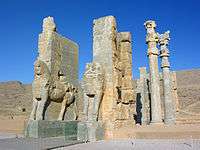Paduspanids
| Paduspanid dynasty | ||||||||||
| پادوسبانیان | ||||||||||
| ||||||||||
 Map of the normal domains of the Paduspanids in Tabaristan | ||||||||||
| Capital | Not specified | |||||||||
| Languages | Persian Caspian languages | |||||||||
| Religion | Zoroastrianism (655-15th-century) Islam (15th-century-1598) | |||||||||
| Government | Monarchy | |||||||||
| Ispahbadh Ustandar Malek | ||||||||||
| • | 665–694 | Paduspan I (first) | ||||||||
| • | 1590–1598 | Jahangir IV (last) | ||||||||
| Historical era | Middle Ages | |||||||||
| • | Established | 655 | ||||||||
| • | Safavid conquest | 1598 | ||||||||
| ||||||||||
| Part of a series on the History of Tabaristan |
|---|
|
Ancient periods paces
|
|
Sasani Houses |
|
Sasani period |
|
Shi'a period
|
|
Modern period
|
|
The Paduspanids or Baduspanids (Persian: پادوسبانیان) were a local dynasty of Tabaristan which ruled over Royan, Nur and Rostamdar. The dynasty was established in 665,[1] and ended in 1598 when the Safavids invaded their domains.[2]
History
The founder of the Paduspanid dynasty was Paduspan I, (also known by the Arabicized form Baduspan), who was the son of Gil Gavbara,[2] the founder of the Dabuyid dynasty. Thus making the Paduspanids of Sasanian descent like the Dabuyids.
Known Paduspanid rulers
- 655-694 : Paduspan I
- 694-723 : Khur-zad
- 723-762 : Paduspan II
- 762-791 : Shahriyar I ibn Paduspan
- 791-822 : Wandad Umid
- 822-855 : Abdallah ibn Wandad
- 855-??? : Faridun ibn Qarin
- ???-??? : Paduspan III
- ???-??? : Shahriyar II ibn Paduspan
- 887-899 : Hazar Sandan
- 899-938 : Shahriyar III ibn Jamshid
- 938-965 : Shams al-Muluk Muhammad
- 965-??? : Istwandad
- ????-???? : Fakhr al-Dawla Namavar I
- ????-1117 : Hazarasp I
- 1117-1168 : Shahrivash
- 1168-1184 : Kai Ka'us I
- 1184-1190 : Hazarasp II
- 1190-1209 : Bavandid occupation
- 1209-1213 : Zarrinkamar
- 1213 -1223 : Bisotun I
- 1223-1242/1243 : Fakhr al-Dawla Namavar II
- Mort en 1242 : Hosam al-Dawla Ardashir
- 1242- ???? : Eskandar I
- 1242-1272 : Shahragim
- 1272-1301 : Fakr-al-Dawla Namavar III Shah-Ghazi
- 1301-1311 : Kai-Khosrow
- 1311-1317 : Shams al-Muluk Mohammad
- 1317-1324 : Nasir al-Din Shahriyar
- 1324-1333 : Taj al-Dawla Ziyar
- 1333-1359 : Eskandar II
- 1359-1378 : Fakhr al-Dawla Shah-Ghazi
- 1378-1379 : Azod al-Dawla Qobad
- 1379-1391 : Marashiyan occupation
- 1391-1394 : Sa'd al-Dawla Tus
- 1394- : Eskandar III
- 1399-1453 : Kayumarth I
- 1453 : Kayumarth II
Nur branch
- 1453-1467 : Ka'us II
- 1467-1499 : Jahangir I
- 1499-1507 : Bisotun II
- 1507-1550 : Bahman of Tabaristan
- 1550-1576 : Kayumarth IV
- 1582-1586 : Sultan Aziz
- 1586-1593/1594 : Jahangir III
Kojur branch
- 1453-1476 : Eskandar IV
- 1476-1491 : Taj-al-Dawla ibn Eskandar
- 1491-1507 : Ashraf ibn Taj al-Dawla
- 1507-1543 : Ka'us III
- 1543-1555 : Kayumarth III
- 1555-1567 : Jahangir II
- 1568-1590 : Sultan Mohammad ibn Jahangir
- 1590-1598 : Jahangir IV
References
- ↑ The Political and Dynastic History of the Iranian World (A.D. 1000-1217), C.E. Bosworth, The Cambridge History of Iran, Volume 5, ed. J. A. Boyle, John Andrew Boyle, (Cambridge University Press, 2001), 29.
- 1 2 BADUSPANIDS, W. Madelung, Encyclopaedia Iranica
Sources
- Madelung, W. (2010). "BADUSPANIDS". Encyclopaedia Iranica, Online Edition. Retrieved 20 January 2014.
- Madelung, W. (1975). "The Minor Dynasties of Northern Iran". In Frye, R.N. The Cambridge History of Iran, Volume 4: From the Arab Invasion to the Saljuqs. Cambridge: Cambridge University Press. pp. 198–249. ISBN 978-0-521-20093-6.
- Frye, R.N. (1975). "The Saljuq and Mongol periods". In Frye, R.N. The Cambridge History of Iran, Volume 5: The Iranian world. Cambridge: Cambridge University Press. pp. 1–659. ISBN 0-521-20093-8.
This article is issued from Wikipedia - version of the 11/18/2016. The text is available under the Creative Commons Attribution/Share Alike but additional terms may apply for the media files.
